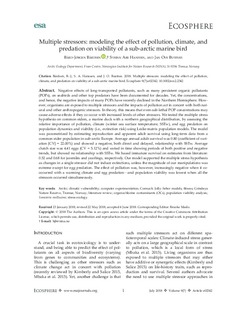| dc.contributor.author | Bårdsen, Bård-Jørgen | |
| dc.contributor.author | Hanssen, Sveinn Are | |
| dc.contributor.author | Bustnes, Jan Ove | |
| dc.coverage.spatial | Grindøya Nature Reserve, Tromsø, Norway | nb_NO |
| dc.date.accessioned | 2018-07-19T08:19:50Z | |
| dc.date.available | 2018-07-19T08:19:50Z | |
| dc.date.created | 2018-07-17T13:51:08Z | |
| dc.date.issued | 2018 | |
| dc.identifier.issn | 2150-8925 | |
| dc.identifier.uri | http://hdl.handle.net/11250/2506080 | |
| dc.description.abstract | Negative effects of long-transported pollutants, such as many persistent organic pollutants (POPs), on seabirds and other top predators have been documented for decades. Yet, the concentrations, and hence, the negative impacts of many POPs have recently declined in the Northern Hemisphere. However, organisms are exposed to multiple stressors and the impacts of pollution act in concert with both natural and other anthropogenic stressors. In theory, this means that even sub-lethal POP concentrations may cause adverse effects if they co-occur with increased levels of other stressors. We tested the multiple stress hypothesis on common eiders, a marine duck with a northern geographical distribution, by assessing the relative importance of pollution, climate (winter sea surface temperature; SSTw), and egg predation on population dynamics and viability (i.e., extinction risk) using Leslie-matrix population models. The model was parametrized by estimating reproduction and apparent adult survival using long-term data from a common eider population in sub-arctic Europe. Average annual adult survival was 0.80 (coefficient of variation [CV] = 22.00%) and showed a negative, both direct and delayed, relationship with SSTw. Average clutch size was 4.41 eggs (CV = 5.12%) and varied in time showing periods of both positive and negative trends, but showed no relationship with SSTw. We based immature survival on estimates from literature: 0.52 and 0.68 for juveniles and yearlings, respectively. Our model supported the multiple stress hypothesis as changes in a single stressor did not induce extinctions, unless the magnitude of our manipulations was extreme except for egg predation. The effect of pollution was, however, increasingly negative when it cooccurred with a warming climate and egg predation—and population viability was lowest when all the stressors occurred simultaneously. | nb_NO |
| dc.language.iso | eng | nb_NO |
| dc.rights | Navngivelse 4.0 Internasjonal | * |
| dc.rights.uri | http://creativecommons.org/licenses/by/4.0/deed.no | * |
| dc.subject | arctic | nb_NO |
| dc.subject | climatic vulnerability | nb_NO |
| dc.subject | computer experimentation | nb_NO |
| dc.subject | Cormack–Jolly–Seber models | nb_NO |
| dc.subject | fitness | nb_NO |
| dc.subject | Grindøya Nature Reserve, Tromsø, Norway | nb_NO |
| dc.subject | literature review | nb_NO |
| dc.subject | organochlorine contaminants (OCs) | nb_NO |
| dc.subject | population viability analysis | nb_NO |
| dc.subject | Somateria mollissima | nb_NO |
| dc.subject | stress ecology | nb_NO |
| dc.title | Multiple stressors: modeling the effect of pollution, climate, and predation on viability of a sub-arctic marine bird | nb_NO |
| dc.title.alternative | Multiple stressors: modeling the effect of pollution, climate, and predation on viability of a sub-arctic marine bird | nb_NO |
| dc.type | Journal article | nb_NO |
| dc.type | Peer reviewed | nb_NO |
| dc.description.version | publishedVersion | nb_NO |
| dc.rights.holder | © 2018 The Authors | nb_NO |
| dc.subject.nsi | VDP::Matematikk og Naturvitenskap: 400::Zoologiske og botaniske fag: 480 | nb_NO |
| dc.source.volume | 9 | nb_NO |
| dc.source.journal | Ecosphere | nb_NO |
| dc.source.issue | 7 | nb_NO |
| dc.identifier.doi | 10.1002/ecs2.2342 | |
| dc.identifier.cristin | 1597666 | |
| cristin.unitcode | 7511,4,0,0 | |
| cristin.unitname | Tromsø | |
| cristin.ispublished | true | |
| cristin.fulltext | original | |
| cristin.qualitycode | 1 | |

